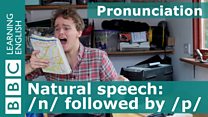Unit 7: Towards advanced
Grammar, news, vocabulary and pronunciation
Select a unit
- 1 Towards advanced
- 2 Towards advanced
- 3 Towards advanced
- 4 Towards advanced
- 5 Towards advanced
- 6 Towards advanced
- 7 Towards advanced
- 8 Towards advanced
- 9 Towards Advanced
- 10 Towards Advanced
- 11 Towards Advanced
- 12 Towards Advanced
- 13 Towards Advanced
- 14 Towards Advanced
- 15 Towards Advanced
- 16 Towards Advanced
- 17 Towards Advanced
- 18 Towards Advanced
- 19 Towards Advanced
- 20 Towards Advanced
- 21 Towards Advanced
- 22 Towards Advanced
- 23 Towards Advanced
- 24 Towards Advanced
- 25 Towards Advanced
- 26 Towards Advanced
- 27 Towards Advanced
- 28 Towards Advanced
- 29 Towards Advanced
- 30 Towards Advanced
Session 5
Tim's Pronunciation Workshop: Linking /w/
Tim shows us how to join words together in spoken English with a linking /w/
Activity 1
Tim's Pronunciation Workshop: Linking /w/
That shoe is on the wrong foot
Tim's back in his pronunciation workshop. This time he's looking at an aspect of connected speech called linking /w/. Find out what it is and how to use it - and why Tim needs an ambulance!
To do
Take a look at the video, then try the activity to do some practice.
Watch the video and complete the activity

Tim
Hi, I'm Tim and this is my pronunciation workshop. Here, I'm gonna show you how English is really spoken. It'll help you become a better listener and a more fluent speaker. Come on, let's go inside. When we speak English fluently we sometimes add extra sounds in between the words to help them link together. Now, have a look at my feet. What's wrong with this? Let's ask the people of London:
Voxpops
The shoe is on the other foot.
The shoe is on the wrong foot.
The shoe is on the wrong foot.
The shoe is on the wrong foot.
Tim
'Shoe' ends in the sound /u:/ and 'is' begins with the sound /ɪ/. But can you hear another sound linking them together? Have another listen:
Voxpops
The shoe is on the other foot.
The shoe is on the wrong foot.
.he shoe is on the wrong foot.
The shoe is on the wrong foot.
Tim
When one word ends in an /u:/ sound and the next begins in a vowel sound we can just about hear another sound in between. This sound is a bit like /w/. So 'The shoe is…' becomes 'The shoewis'. This is called the linking /w/ - but it's important to remember that it's not a full /w/ sound. It happens because the mouth moves from an /u:/ sound to a vowel sound and on the way it passes through the /w/ mouth shape. Here are some more examples:
Examples
When do I have to be there?
I haven't got a clue at all.
That glue is really strong.
I really can't do it.
Tim
So, you've heard the examples, and now it's your turn. Are you ready? Listen and repeat.
Examples
When do I have to be there?
I haven't got a clue at all.
That glue is really strong.
I really can't do it.
Tim
Well done. Now remember, if you want to learn more about pronunciation, please visit our website, bbclearningenglish.com. And that's about it from the pronunciation workshop this week. See you soon. Bye. Now I really must get this other shoe on, otherwise I'm going to have an accident. Aaah! Too late.
To do
Got that? Now try this activity to get some more practice.
The linking /w/ game
7 Questions
How many examples of linking /w/ are there in each sentence? You decide...
Help
Activity
How many examples of linking /w/ are there in each sentence? You decide...
Hint
When a word ends with an /u:/ sound and the next word starts with a vowel sound, we often use a linking /w/.Question 1 of 7

Help
Activity
How many examples of linking /w/ are there in each sentence? You decide...
Hint
When a word ends with an /u:/ sound and the next word starts with a vowel sound, we often use a linking /w/.Question 2 of 7

Help
Activity
How many examples of linking /w/ are there in each sentence? You decide...
Hint
When a word ends with an /u:/ sound and the next word starts with a vowel sound, we often use a linking /w/.Question 3 of 7

Help
Activity
How many examples of linking /w/ are there in each sentence? You decide...
Hint
When a word ends with an /u:/ sound and the next word starts with a vowel sound, we often use a linking /w/.Question 4 of 7

Help
Activity
How many examples of linking /w/ are there in each sentence? You decide...
Hint
When a word ends with an /u:/ sound and the next word starts with a vowel sound, we often use a linking /w/.Question 5 of 7

Help
Activity
How many examples of linking /w/ are there in each sentence? You decide...
Hint
When a word ends with an /u:/ sound and the next word starts with a vowel sound, we often use a linking /w/.Question 6 of 7

Help
Activity
How many examples of linking /w/ are there in each sentence? You decide...
Hint
When a word ends with an /u:/ sound and the next word starts with a vowel sound, we often use a linking /w/.Question 7 of 7

Excellent! Great job! Bad luck! You scored:
End of Unit 7
We hope that was useful. In Unit 8, Sian brings you another English Masterclass - in this one, she'll be talking about when the past is not the past. In News Review and LingoHack you can find out which words are making the headlines - and Tim will be back with the pronunciation workshop as usual. See you there!
Session Vocabulary
Linking /w/
When fluent speakers of English say a word that ends with an /u:/ sound, followed by a word beginning with a vowel sound, they often use a soft /w/ sound to link the two words together. Some examples of phrases where this might happen include:- The shoe is on the wrong foot.
- I can't do it.
- You are welcome.


